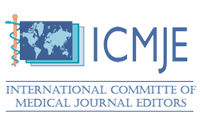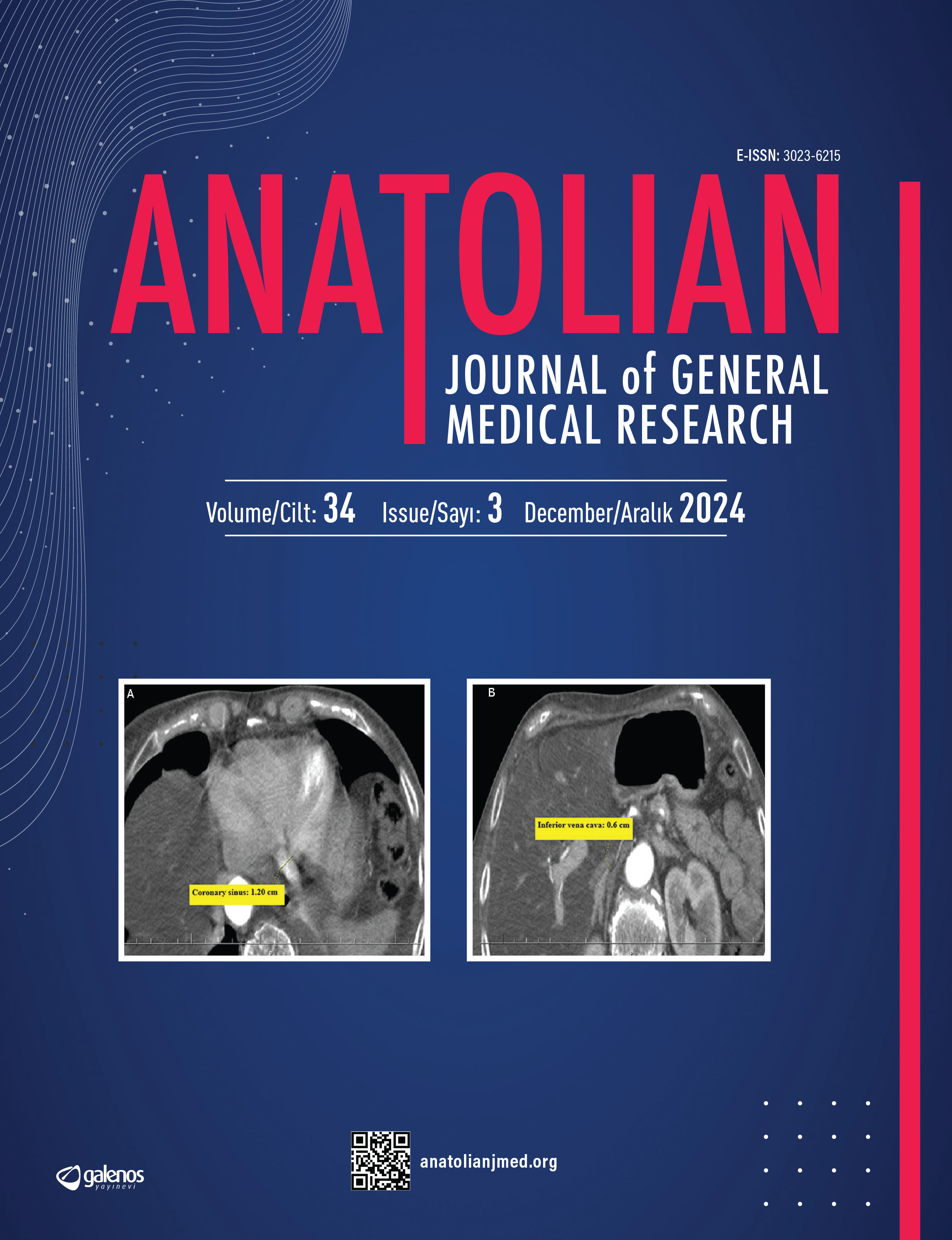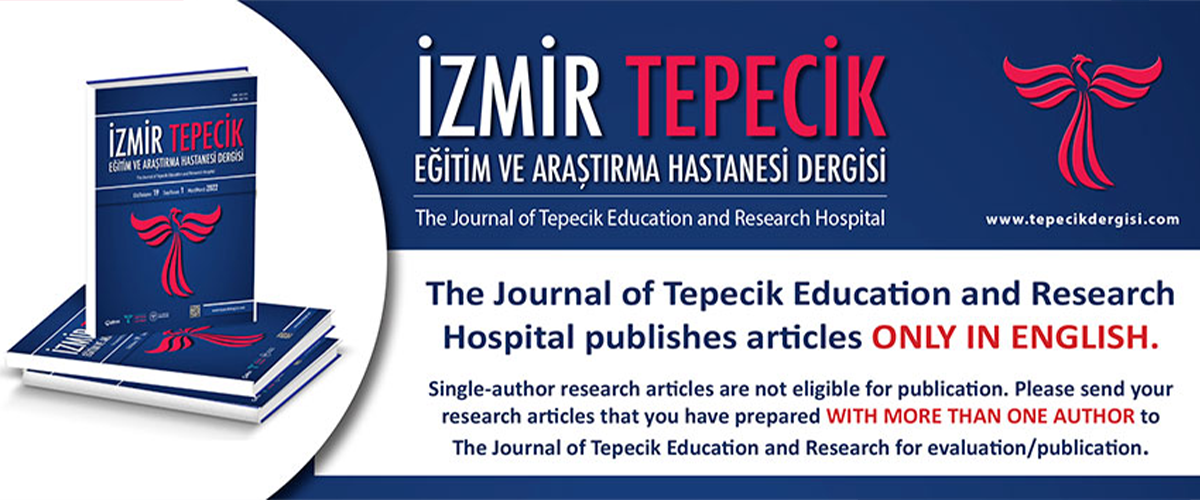








Analysis of the Incidence and Predictive Factors of Chronic Postoperative Pain in Adult Population
Pervin Sutaş Bozkurt1, Zeki Özen2, Elif Kartal2, İlkim Ecem Emre3, Çiğdem Selçukcan Erol2, Fatma Önay Koçoğlu2, Gürcan Güngör1, Cem Güneyli4, Gökçen Başaranoğlu5, Eser Özlem Ünlüsoy1, Özlem Uğur6, Sibel Buluç Bulgen71Department of Anesthesiology and Reanimation, Cerrahpasa Medical Faculty, İstanbul University, Istanbul, Turkey2Department of Informatics, Istanbul University, İstanbul, Turkey
3German Business Informatics, Business Management Faculty, Marmara University, İstanbul, Turkey
4Anesthesiology and Reanimation Clinic, Tepecik Education and Training Hospital University of Health Sciences, izmir, Turkey
5Department of Anesthesiology and Reanimation, Faculty of Medicine Bezmialem University, İstanbul
6Department of Anesthesiology and Reanimation, Haseki Cardiology Institute, Istanbul University, Istanbul, Turkey
7Anesthesiology and Reanimation Clinic, Istanbul Education and Training Hospital University of Health Sciences, Istanbul, Turkey
INTRODUCTION: Chronic postoperative pain (CPOP) adversely affects the quality of patients’ lives and can cause medical and legal problems and economic loss, due to workforce loss. There is no research showing the incidence of CPOP in Turkey. The aim of this study was to find the most prominent factor in the development of CPOP in patients who undergo any kind of surgical procedure.
METHODS: Patients (165 women and 146 men) who were operated on in five hospitals were included in the study. A patient data sheet and follow-up form were prepared. All patients were followed up for 2 months by telephone calls and were asked about their pain scores. When patients reported pain in 2nd month after their operation, they received re-evaluation and consultation from the pain department.
RESULTS: Results
Sixty-seven patients complained of prolonged pain at the area of surgery 2 months after their surgery, and 46 of these patients (14.7%) were diagnosed with CPOP. The presence of CPOP was statistically significant when patients were grouped by age: 18–45 years (A) and older than 45 years (B). A statistically significant relationship was found between CPOP diagnosis and ASA scores. According to the results, an age older than 45 years and an ASA score of 3 play a major role in the development of CPOP.
DISCUSSION AND CONCLUSION: Contrary to previous literature, this study found that factors such as socio-economic status, operation type and extent, geographical region, body mass index, gender, previous experience of pain, drug use and the presence of some neuropathy-related chronic diseases had no effect on the possibility of CPOP. However, ASA scores and age played major roles in the development of CPOP.
Yetişkin Popülasyonda Postoperatif Kronik Ağrı İnsidansı ve Prediktif Faktörlerin Analizi
Pervin Sutaş Bozkurt1, Zeki Özen2, Elif Kartal2, İlkim Ecem Emre3, Çiğdem Selçukcan Erol2, Fatma Önay Koçoğlu2, Gürcan Güngör1, Cem Güneyli4, Gökçen Başaranoğlu5, Eser Özlem Ünlüsoy1, Özlem Uğur6, Sibel Buluç Bulgen71İstanbul Üniversitesi, Cerrahpaşa Tıp Fakültesi, Anesteziyoloji ve Reanimasyon Anabili Dalı, İstanbul2İstanbul Universitesi, Enformatik Anabiilim Dalı, İstanbul
3Marmara Üniversitesi, İşletme Fakültesi,Almanca İşletme Enformatik Anabilim Dalı, İstanbul
4Sağlık Bilimleri Üniversitesi, Tepecik Eğitim Araştırma Hastanesi Anesteziyoloji ve Reanimasyon Kliniği, İzmir
5Bezm-i Alem Universitesi Tıp Fakültesi, Anesteziyoloji ve Reanimasyon Anabili Dalı, İstanbul
6İstanbul Üniversitesi, Haseki Kardioloji Enstitüsü, Anesteziyoloji ve Reanimasyon Anabili Dalı, İstanbul
7Sağlık Bilimleri Üniversitesi,istanbul Eğitim Araştırma Hastanesi, Anesteziyoloji ve Reanimasyon Kliniği, İstanbul
GİRİŞ ve AMAÇ: Ameliyat Sonrası Kronik Ağrı (ASK) hastaların yaşam kalitesini olumsuz etkileri yanısıra tıbbi ve hukuki sorunlara neden olur ve işgücü kaybı nedeniyle ekonomik kayıpları doğurur. Türkiye'de ASK insidansını gösteren herhangi bir araştırma bulunmamaktadır. Bu çalışmanın amacı, her türlü cerrahi girişimden geçecek olan hastaların ASK gelişiminde en belirgin faktörü bulmaktır.
YÖNTEM ve GEREÇLER: Çalışmaya, beş hastanede ameliyat edilen hastalar (165 kadın, 146 erkek) dahil edilmiştir. Hasta veri kayıt ve takip formu hazırlanmıştır. Tüm hastalar ağrı skorlarının sorulduğu telefon görüşmeleri ile 2 ay takip edilmiştir. İkinci ayda hastalardan ağrısı olduğunu bildirenler, ağrı bölümü tarafından yeniden değerlendirmeye alınmıştır.
BULGULAR: Altmış yedi olgu, cerrahiden iki ay sonra cerrahi müdahale yapılan bölgede uzun süreli ağrı şikâyetinde bulunmuş ve 46 hastada ASK tanısı konulmuştur (% 14,7). Vakalar, 18-45 yaş (A) ve 45 yaşından büyük (B) olarak gruplandırıldığında, ASK’ın varlığı istatistiksel olarak anlamlı bulunmuştur. ASK ve ASA skoru arasında istatistiksel olarak anlamlı ilişki tespit edilmiştir. Elde edilen sonuçlara göre, 45 yaş üstü ve ASA skoru 3 olan hastalarda ASK oranı daha yüksektir.
TARTIŞMA ve SONUÇ: Literatürün aksine, sosyo-ekonomik durum, ameliyat tipi ve derecesi, coğrafi bölge, vücut kitle indeksi, cinsiyet, ağrı ilaçları, sigara/alkol
bağımlılığı ve bazı nöropati ile ilgili kronik hastalıkların varlığı gibi diğer faktörlerin ASK olasılığında etkisi yoktur. Bununla birlikte, ASA ve yaş, ASK olasılığında önemli rol oynamaktadır.
Manuscript Language: English
(992 downloaded)




